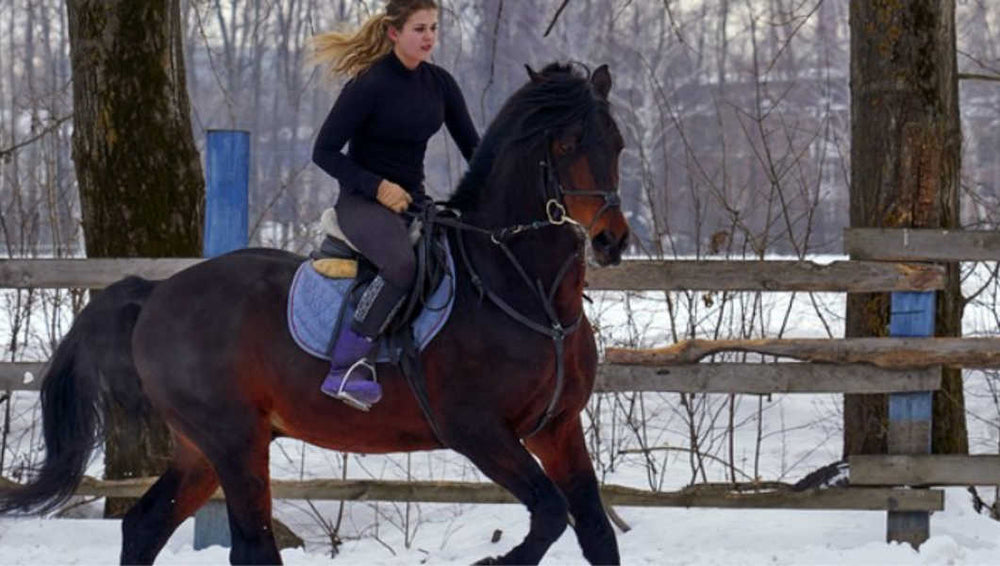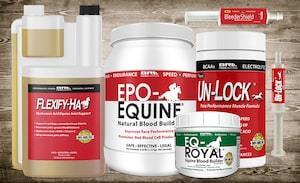
With winter cold now reaching much of the country, keeping your performance horse fit and in work becomes more of a challenge. Even with access to an indoor ring, you’ll need to adjust your horse’s workouts a bit in order to help keep him safe. Is your winter workout up to par? These four tips can help to prevent injuries and keep your horse in steady work so you’re ready for spring.
Proper Warmups and Cool-Downs
As the temperature drops, aim to extend or even double the time of your warmups and cool-downs. If you’ve ever tried to go for a run without stretching or warming up, you understand how stiff and awkward your legs can feel. Warmups help to slowly increase your horse’s body temperature. Pay attention to how your horse feels and only progress to your workout when your horse is supple, focused and moving forward freely.
Evaluating Footing For Safety
Winter weather can quickly change the quality of the footing, and a trip or stumble on frozen ground can easily cause soft tissue injuries or even fractures. Before each ride, walk at least part of the area where you’ll be working to check the footing. If there’s ice present, or if the ground is frozen and rutted, it may be safer to forgo the ride until the conditions improve.
There are a number of ways that you can maintain the footing of an arena or track so you don’t miss out on riding as often. Regular grooming through the winter can help to keep the footing evenly spread and promote drainage. Adding magnesium chloride flakes to your indoor arena footing can also help to prevent freezing, allowing you to get more wintertime use out of the space.
Dealing With Bitter Cold
Bitterly cold temperatures can be hard on your performance horse, and you may need to shorten or forgo the workout for your horse’s safety and comfort. The main challenge of exercising a horse in extreme cold is the large volume of air that your horse takes in, and the effect it has on your horse’s lungs and airway. According to a study performed at Oklahoma State University, horses that cantered for five minutes in cold air experienced airway changes that may lead to the development of chronic airway disease.
Cold weather can also increase exercise-induced pulmonary hemorrhaging (EIPH), or bleeding. BleederShield promotes the repair of EIPH-damaged lungs, and supports healthy lung function in both race and competition horses. It’s an easy way to support your horse’s health during winter training.
When temperatures dip below freezing, adjust your workouts to compensate. Try to work your horse during the warmest part of the day, and you may need to scale back the intensity of the workouts. When the air is so cold that it hurts to breathe, then it may be best to cancel training sessions until temperatures rise.
Monitoring Your Horse
Careful monitoring can help you to get a sense of how well your horse is coping with the weather and with training. Watch for labored breathing, lack of energy, reluctance to move forward, unusual fatigue and overall body stiffness. These are all signs that your horse may be having trouble.
Flexibility is key in keeping a performance horse in work through the winter. Remember that even long walking sessions can be beneficial to your horse, so adjust your training to the weather and conditions in order to minimize the chance of injury.
If your horse is a bleeder, learn more about how BleederShield can help with your horse’s winter workouts, and order today.
Top trainers, owners and competitors rely on BRL Equine products to help their horses perform at their very best. You can get the same great results! Our all-natural equine nutritional supplements really work... guaranteed or your money back!





Also in Horse Tips and More
Top 10 Ways to Show Your Horse You’re Thankful For Him
November 01, 2021
View full article →
5 Ways to Prepare Your Barn For Summer
May 03, 2021
View full article →
Your New Spring Horse Health Checklist
March 12, 2021
View full article →